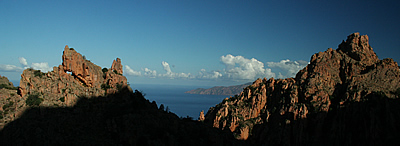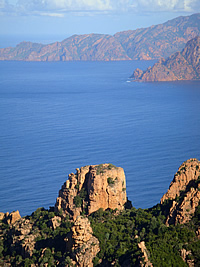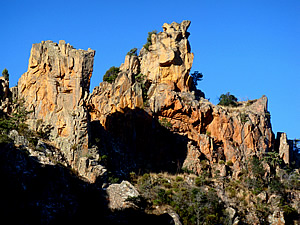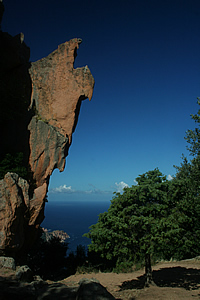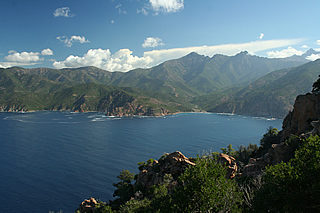

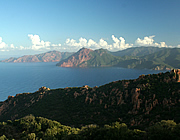
Corsica has so much: mountains, secluded coves, turquoise seas, great food, beautiful Romanesque churches.
We spent the first part of our holiday travelling anti-clockwise round the island from Bastia, through Cap Corse, to Calvi and down to the Calanches.
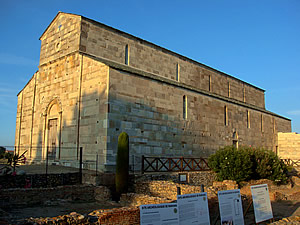
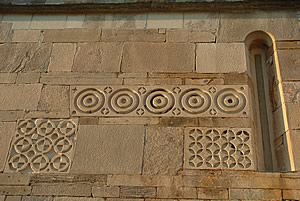
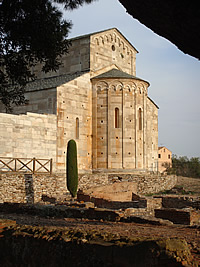
We had been planning to come to Corsica for some time as it had rave reviews from friends and the owner of our local independent travel agent in Harrogate, Traveltalk, and so we finally made it with a plan to visit most of the island!
As our flight arrived early evening in Bastia, and we had a car to collect, we chose a hotel quite close to the airport, the Jardins de la Madrague - it was certainly convenient for the airport and not bothered by aircraft noise, but nothing special.
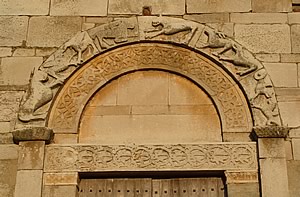
On that first evening we headed to the coast, not very far away, to eat, stopping to admire the beautiful twelfth century church La Canonica on the way.
A lovely, simple Romanesque in white stone with Lombardy arches, and primitive carvings above the west door, it is right next to the remains of the 1st century BC Roman town of Mariana - lots of foundations but much is covered with plastic sheeting. A couple of days later we came back in the early morning when the light was on the east front.
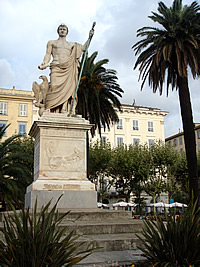
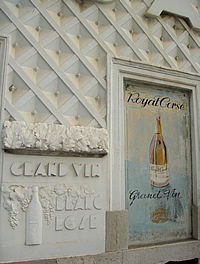
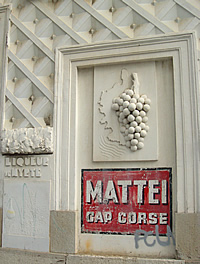
La Canonica is one of around 300 churches built by the Pisans when they ruled the island from the late eleventh century for little more than a century. Genoa took over the island from the Pisans, making Bastia the capital and encouraging agricultural diversity including olives, vines and chestnut trees. Bastia is now a pleasant, relaxed town and thriving passenger and freight terminal. The large Place St Nicholas, lined with cafés looking out towards the sea and docked ferries, is a good place to relax and have a meal or a drink. We happened to visit on a Sunday morning for breakfast when the square is occupied by a large flea market (mostly junk) overlooked by a wonderfully camp statue of Napoleon draped in a sheet.
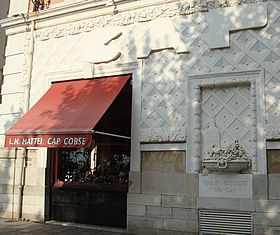
Napoleon was born to a noble Corsican family in 1769, the year the French took over the island from the Genoese after years of Corsican rebellion, and his childhood and education were dominated by French influences. The French Revolution in 1789 triggered further uprisings in Corsica and Napoleon's family fled to France where Napoleon had been serving in the French army since 1785. He himself returned to Corsica to take part in the complex struggles of the people, eventually coming into conflict with Pascal Paoli, the charismatic Corsican leader, who appears to have been something of a royalist as well as the architect of Corsica's democratic constitution. Napoleon developed a strong antipathy for his birthplace during the course of his dealings with the various uprisings - an antipathy which was returned in full measure by the islanders themselves until very recently when he began to be reclaimed by more than Ajaccio, the town of his birth.
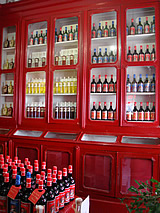
Not far from Napoleon's statue on Place St Nicholas is the lovely Art Deco Maison Mattei a wine merchant established in 1872. As well as an impressive selection of wines it sells several varieties of the Corsican quinine-based aperitif Cap Corse.
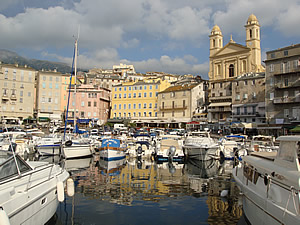
Wandering south through narrow streets it is a short stroll to the Vieux Port, probaby the most picturesque part of the town, also with many places to eat and drink.
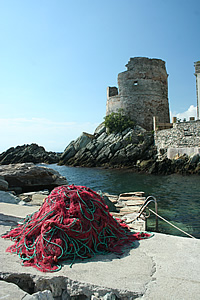
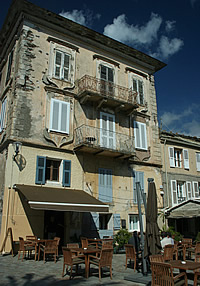
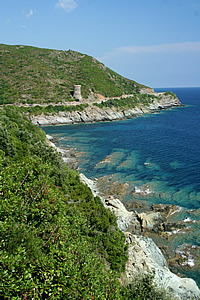
We spent a day exploring Cap Corse. working our way north up the east coast then across the peninsula slightly south of its tip and back down the west coast. Ideally situated for trade with the mainland, but subject to piracy, the coastline is dotted with fortified watchtowers to provide some measure of protection - or at least advance warning. The area has some of the most beautiful coastal landscape with small fishing villages and the legacy of the Pisans who settled here in the tenth century, building their beautiful churches.
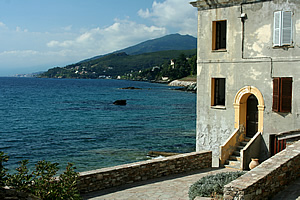
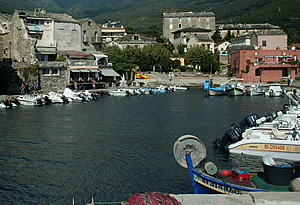
Erbalunga, about 10km north of Bastia, is an unspoilt fishing village, hopefully it won't become commercialised. Down by the small peaceful harbour the quay is piled with nets and guarded by a crumbling watchtower. Nearby are fine buildings, slightly dilapidated but obviously once noble family homes, and several inviting restaurants.
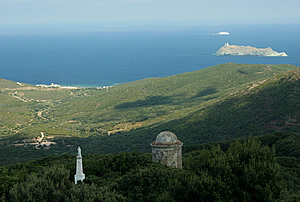
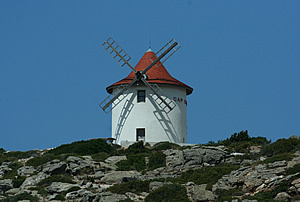 Old windmill at Col de la Serra, restored by the Mattei family
Old windmill at Col de la Serra, restored by the Mattei family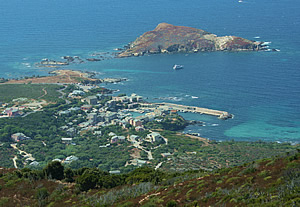 Centuri Port
Centuri Port 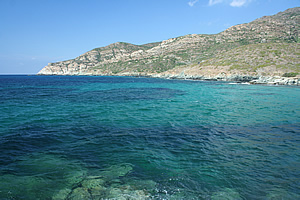 Coast near Centuri Port
Coast near Centuri Port
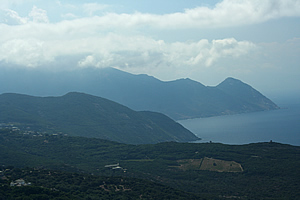 West Coast of Cap Corse towards Desert des Agriates, from Col de la Serra
West Coast of Cap Corse towards Desert des Agriates, from Col de la Serra
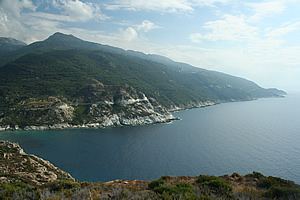
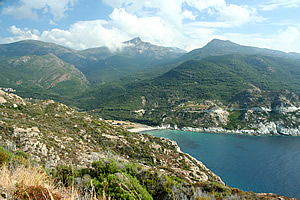
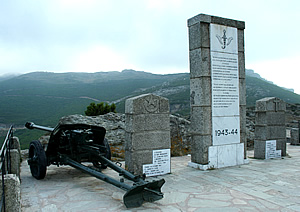
We meandered up the lovely coastline to Macinaggio where the road turns inland. Here we stopped to try to visit the Clos Nicrosi for a taste of the local wines but had no luck in finding the place until we spotted it on the road on the way out!
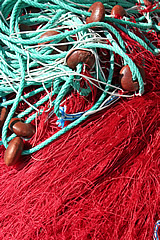
The road across the peninsula is in a very poor state. almost completely without a decent surface in places and full of potholes. Views are superb, though, especially at Col de la Serra, where the north and west coasts are both visible.
We made our way to Centuri-Port for lunch. This popular, and still unspoilt, village has many restaurants and cafes to choose from. We chose U Cabalu di Mare and ate on their small, shady terrace overlooking the harbour. Excellent fish soup but rather tasteless swordfish. Nice crisp Clos San Quilico was very good with the fish. Tried the local speciality Piazzu which was rather stodgy, again fairly tasteless, custard tart served with a caramel sauce - light years away from the custard tarts of Sintra in Portugal (good tarte au citron though!).
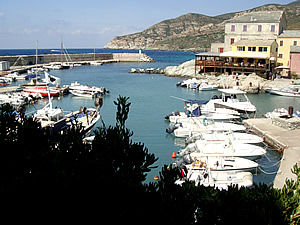
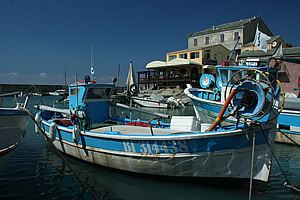
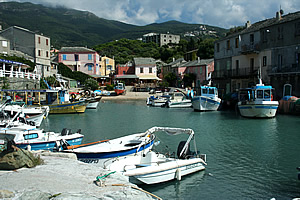
The west coast of Cap Corse is much more rugged than the east: dramatic mountains dropping straight into a turquoise sea. Here and there small bays, and a remarkable black beach at Alba. The corniche road is great to drive, hanging between the maquis-covered interior and a steep drop to the sea.
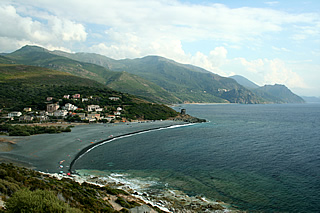
The maquis seems to be unique to Corsica - a thick tangle of tough shrubs with a lovely distinct smell. Several times we tried dishes cooked in maquis herbs and loved them - lamb is particularly good.
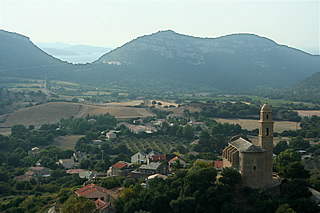
The road passes through Patrimonio with its lovely sixteenth century church St Martin and on up to the Col de Teghime where there is a memorial to those who died in a battle with the German army in 1943. During three days of intensive fighting, 49 were killed and 130 injured - many were North African Berbers. Teghime was taken on the 3rd October and the following day the Corsicans entered Bastia and the Germans withdrew.
It was late and a bit cool when we were there but we could easily see down to the east coast - on a clear day both east and west coasts can be seen.
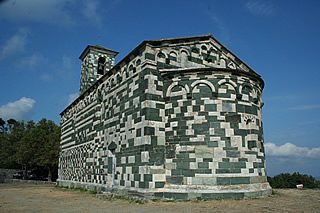
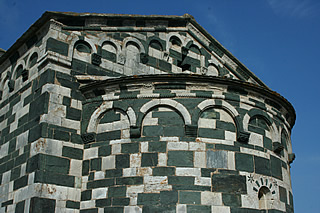
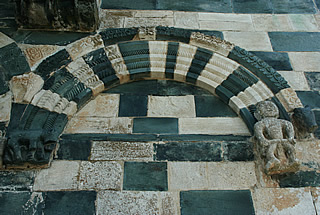
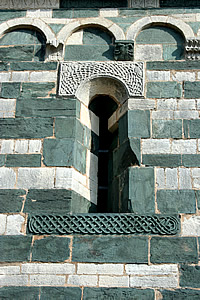
Though La Canonica is lovely, the church of San Michele de Murato is an absolute stunner. A late thirteenth century Pisan church, it stands alone on a low hilltop on the edge of the village of Murato in the Nebbio. It is built in a striking mix of dark green serpentine and white marble. The bell tower is a late nineteenth century addition - try to imagine the building without it. The exterior is adorned with beautiful Lombardy arches below the eaves of the single-naved building, geometric, animal and human carvings bind the ends of arches together. Three more elaborate blind arches on the west front have carved rope and patterned decoration as well as beasts and human figures. Wonderful primitive carvings of humans, beasts, flowers and celtic-like patterns also adorn the window surrounds.
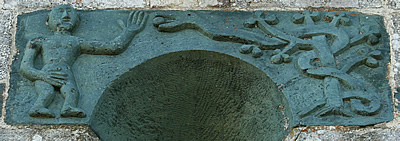


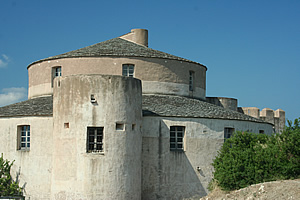
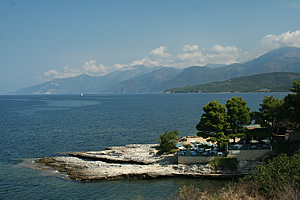
St Florent was another leisurely destination for lunch as we crossed the island making for our next stay in Calvi. It has a large marina, full of motor boats, and plenty of places to eat. We chose le Grand Bleu near the marina which served a very good assiette Corse: cheese, sausage, boar, ham and succulent melon, but a rather poor quality sanglier in sauce Corse, though the taste was good; excellent crepe sucrée flambée but profiteroles were still frozen! A small carafe of local red was also nothing special.
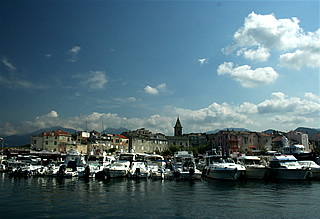
It's another pleasant spot with not a lot to detain visitors, apart from a stroll around the harbour and a round (rebuilt) fifteenth century citadel on a bluff above the town from where there are good views over to Cap Corse. The citadelle was almost completely destroyed by Nelson's fleet which bombarded it for two days in February 1794 - Pascal Paoli had asked for the help of the British against the French as a result of which an Anglo-Corsican Kingdom was declared in June of that year. Disputes over the nature of the shared running of the kingdom led eventually to the British leaving in 1796 and the return of the French.
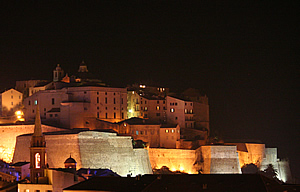
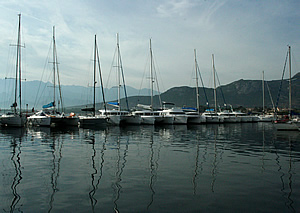
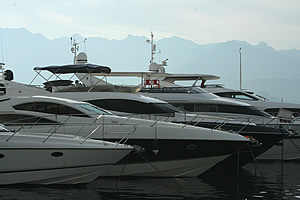
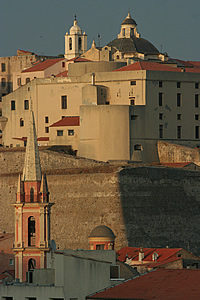
The road to Calvi from St Florent skirts the Desert des Agriates, once a fertile agricultural but now, thanks to fires and soil erosion, a barren, wild landscape, covered with maquis.
Calvi is a large, seafront town, once a fishing port but now, for quite some time, a rather up-market tourist resort.
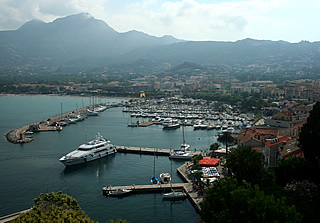
The quai Landry has a very Riviera feel to it, lined with restaurants and palm trees. Its northern end is marked by the Tour du Sel - a medieval watchtower once used to store salt. Above it, on a spur of land, rises the fifteenth century citadelle - within its walls houses are crammed together and the cathedral is also squashed in. Calvi's spectacular beach curves around the bay south of the town.
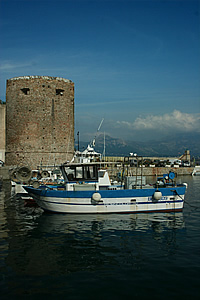
It was a very hot day when we walked up to the citadel so the excellent citron pressées at the little café opposite the cathedral entrance were very welcome - along with the superlative Tarte au Citron and Fondant Chocolat - a very rich chocolate cake; all these are specialities of the region and highly recommended.
We stayed at the Hotel Regina with fantastic views from our room across the bay, the mountains and to the citadel. We spent one evening on our balcony with snacks, water and wine, watching the sun go down, and, one morning, after watching the sun rise on the citadel, turning the bay pink, we had an excellent room service breakfast, also on the balcony - well worth the extra cost for the view.
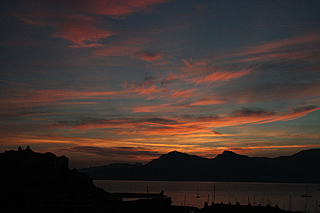
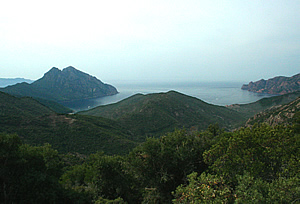 From Col de la Palmorella
From Col de la Palmorella From St Florent we drove the mountain route to Porto and Piana with some fantastic views at Col de la Palmorella and Col de la Croix along the way.
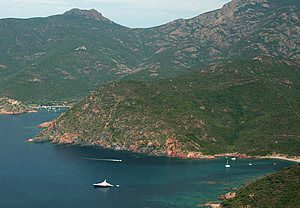
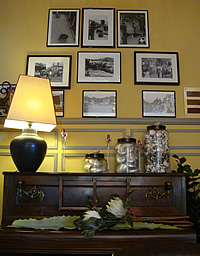
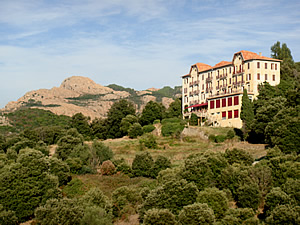
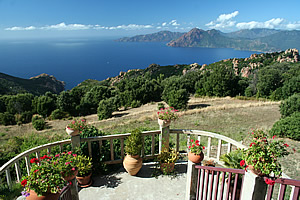
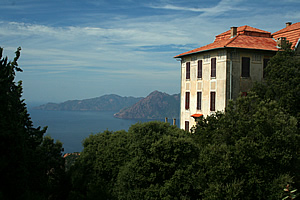
We had wanted to have lunch at Maquis on the outskirts of Porto, but it was packed so we carried on to our hotel, Les Roches Rouges near Piana. We'd heard a lot about this hotel, and it had some quite mixed reviews on Tripadvisor, but many people said it was an absolute must for the atmosphere. It certainly has bags of that, helped along by the owner, a formidable lady who works like a demon and seemed to be constantly busy, but was never anything less than helpful.
Though full of character the hotel has definitely seen better days. The public rooms retain the style and atmosphere of a very early twentieth century hotel, crammed with overstuffed chairs and small tables in the reception/ bar - the hotel was built over a hundred years ago and I believe original furniture is still there.
We had room 337 (actually one large and one smaller room with bathroom) with fantastic views out to sea and the red rocks of the Calanches. On the down side the smaller room had large damp patches on the walls - we closed the door and didn't venture in again after a first look! Even the main room smelt damp so we opened all the windows and it soon cleared. Everything had an aged feel to it, though the bathroom was tiled and clean with a shower cubicle. The lovely tall windows in the main room opened onto small balconies - the windows were equipped with external shutters so some air can be allowed in overnight with the windows open as there is no air conditioning.
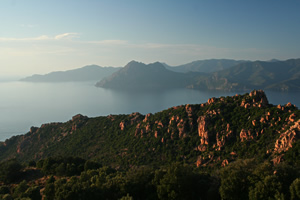
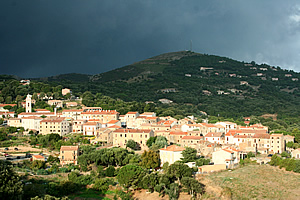
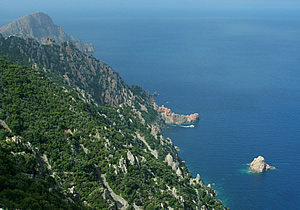
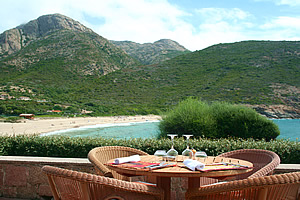
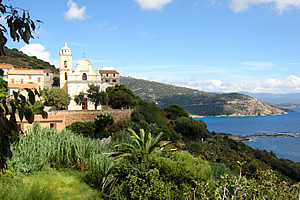
After checking in we walked into Piana and had lunch at Casa Corsa on a shady terrace with great views towards the Calanches. After the long drive we indulged in the local aperitif of Vin Myrt - iced and very good - before very acceptable pizzas.
In the evening the hotel really comes into its own. The sunset must be watched from the terrace with cocktails - the mountains across to Scandola and the red rocks of the Calanches light up and glow. And the food in the restaurant is excellent with impeccable service. The first evening we had the 37Euro menu: saucissons de lapereau aux pistaches, superb lamb, apple & passion fruit crumble made with cardamom and Arlequin sorbet - the best meal we'd had so far!
That first night I woke at 5 a.m. and looking out could see a black sky full of stars and a thunderstorm over the sea towards France - very dramatic! Next morning the storm had hit Corsica and we had breakfast under cover on the terrace with it raging in front of us. Fortunately it cleared up later in the morning and we drove down to Plage d'Arona with more great views out to Capo Rosso on the way. On the top of this craggy red mountain is a Genoese watchtower, the Tour de Turghiu.
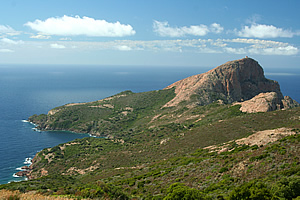
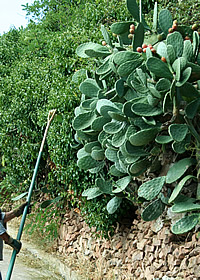 A local harvesting cactus fruit in Cargese
A local harvesting cactus fruit in CargesePlage d'Arone is a gently curved sweep of beach which was almost deserted when we were there, though I believe it is very popular at the height of the tourist season. Casa Bianca overlooks the bay and we had very good pizzas there along with an excellent glass of red wine. After a very leisurely lunch we meandered down to Cargese and rambled through the streets - a quiet village high above a sparkling blue bay, its walls crowded with bougainvillea and hibiscus and elsewhere pomegranates, figs, olives, and vines scattered around.
That night we had dinner in Piana at Casanova. Excellent lasagne al forno and cotes de porc in a fig sauce with proper chips. Andrew tried the local specialty of chestnut mousse but didn't really like it - there are lots of chestnut trees on Corsica but neither of us care for the taste of chestnuts. My nougat glacé was excellent!
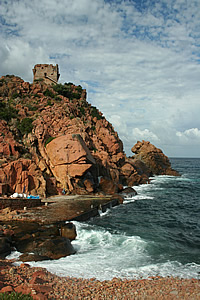
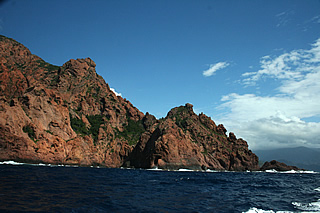
Though the sea was a bit choppy - small boats weren't going out at all - we took one of the larger boats out of Porto to the Scandola nature reserve which is closed to hikers. The only way to get close is to go by sea. It was a three hour trip going right out to the beautiful volcanic rocks and visiting caves and inlets on the way. And the rough sea made for a very exciting trip!
It's a fantastic coastline, with spiky red peaks, perforated cliffs, tilted geological plates, - fascinating! The sea was an amazing range of shades of blue, very deeply coloured.
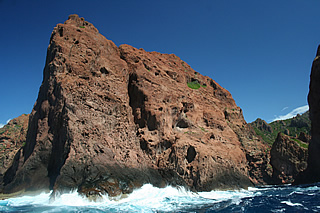
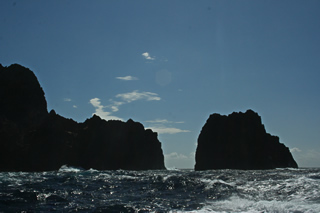
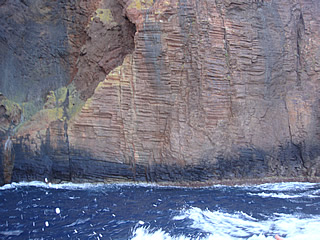
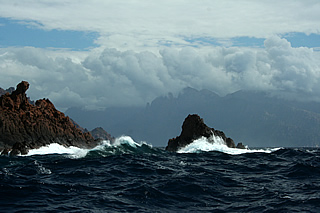
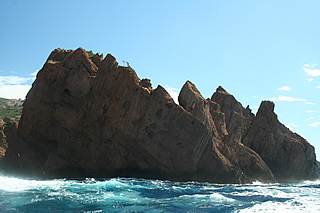
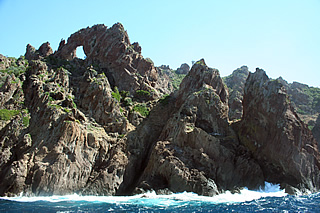
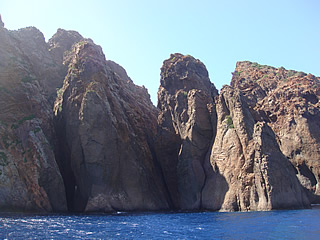
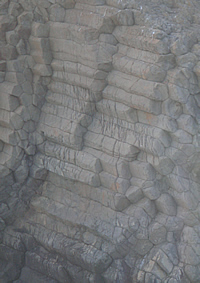
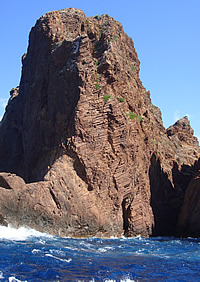
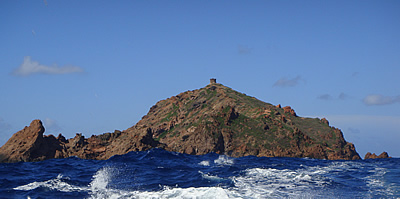
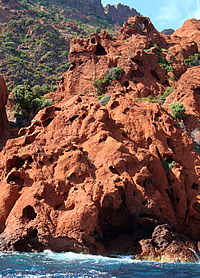
The reserve covers 19 km2 of which 10 km2 is marine, and as well as the wonderful coastline it is noted for its range of wildlife including colourful algae, sea eagles and dolphins. Formed by volcanic activity the geological formations include porphyry, rhyoliths and basaltic pillars.
On the way back there was a half hour stop at Girolata, the isolated village we'd seen from the Col de la Croix.
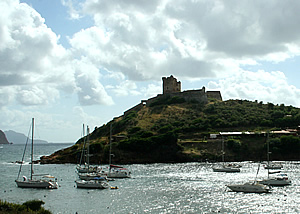
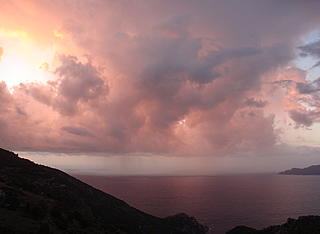
That evening, after watching a spectacular sunset from the terrace. we had another superb dinner at the hotel; king crab, a fabulous chocolate pudding oozing chocolate and nameless local cheeses were highlights! We did ask what kind of cheeses they were but the waitress said they didn't have names - were just from the countryside around here.
Sunrise next morning wasn't too shabby either.
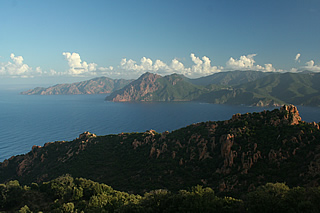
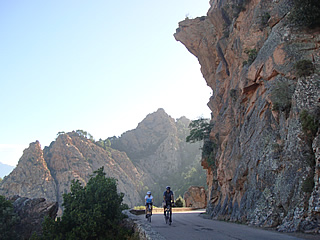
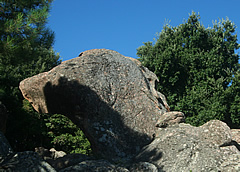
Another UNESCO site, the Calanches is a range of orange-red cliffs and weird rock formations extending high above the sea between Porto and Piana. The road winding through the area is narrow and very busy - we got stuck for an hour one day when tour buses couldn't negotiate the bends.
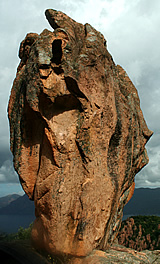
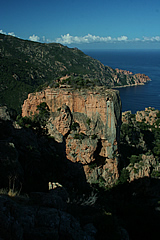 Chateau Fort
Chateau FortWe walked to the Chateau Fort from the Tete de Chien rock formation (what is it with the human condition that we have to look for familiar objects in rock formations!) - there's a car park at the hairpin bend. It only took us 40 minutes there and back and it's a bit of a scramble in places but the views are terrific.
